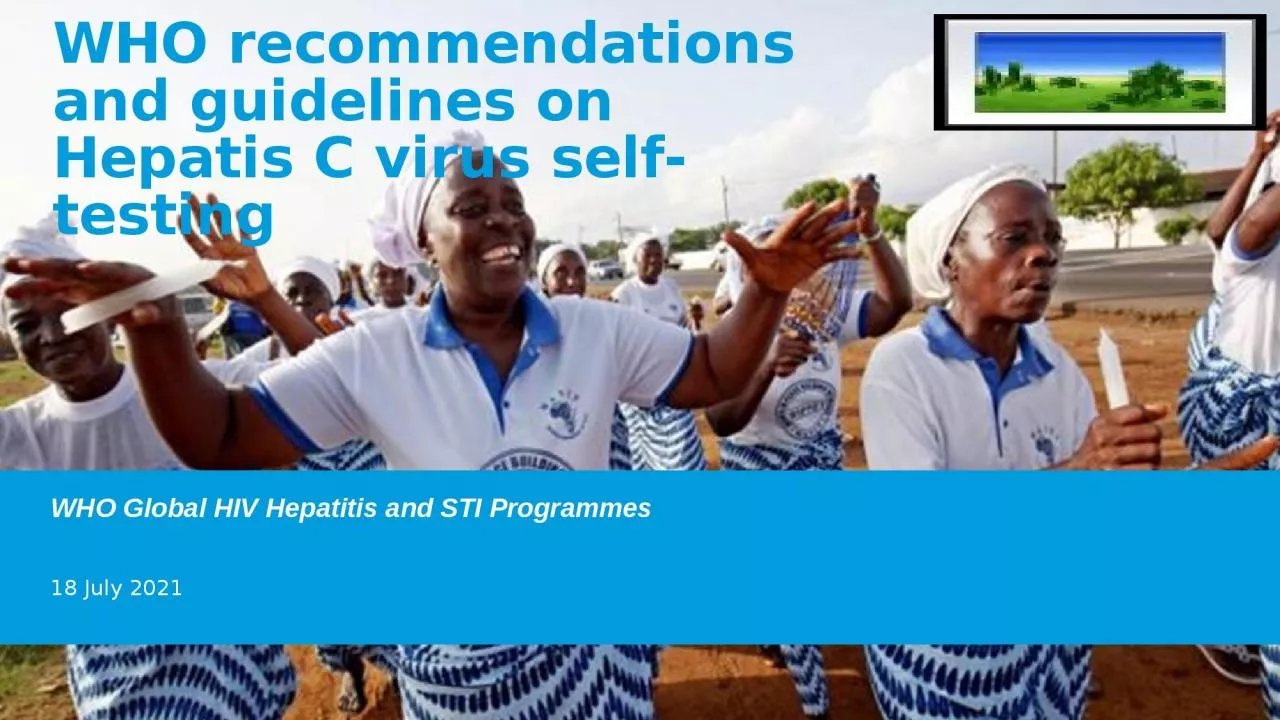

WHO Global HIV Hepatitis and STI Programmes 18 July 2021 WHOs goal is to eliminate viral hepatitis as a major public health problem by 2030 610 million infections in 2015 to 900000 infections by 2030 ID: 1000569
Download Presentation The PPT/PDF document "WHO recommendations and guidelines on He..." is the property of its rightful owner. Permission is granted to download and print the materials on this web site for personal, non-commercial use only, and to display it on your personal computer provided you do not modify the materials and that you retain all copyright notices contained in the materials. By downloading content from our website, you accept the terms of this agreement.
1. WHO recommendations and guidelines on Hepatis C virus self-testingWHO Global HIV Hepatitis and STI Programmes18 July 2021
2. WHO’s goal is to eliminate viral hepatitis as a major public health problem by 2030 6-10 million infections (in 2015) to 900,000 infections (by 2030)1.34 million deaths (in 2015) to under 500,000 deaths (by 2030)
3. Only 21% of estimated 58 million people with chronic HCV infection were diagnosed in 2019 with variation by regions Source: Global progress report on HIV, viral hepatitis and sexually transmitted infections, 2021
4. WHO Hepatitis testing guideline recommendations 2017https://bmcinfectdis.biomedcentral.com/articles/supplements/volume-17-supplement-1TopicRecommendationWho to test?Focused testing for most affected populations*, those with a clinical suspicion of chronic viral hepatitis, family members/children, and sexual partners (HBV), healthcare workers. General population testing: In settings with ≥2% or ≥5% (intermediate/high) HBsAg or HCV Ab prevalence. Birth Cohort testing (HCV): where specific identified birth cohorts of older persons at higher risk of HCV infectionRoutine antenatal clinic testing (HBV)* PWID, people in prisons, MSM, sex workers, HIV-infected, tattoos, transfusions, some migrant pops from endemic countries, some indigenous populations, children of HBV/HCV +ve mothersHow to test?A single serological assay (EIA or RDT) that meets minimum performance standards with prompt NAT testing + linkage to careConfirmation of HCV viraemiaNucleic acid testing (NAT) (quantitative or qualitative RNA) or core HCV antigen assay, with comparable clinical sensitivityPromoting uptake and linkageUse of DBS specimens for virology ± serology On-site or immediate RDT testing with same day resultsTrained peer and lay health workersClinician reminders to prompt provider initiated, facility-based testing Testing as part of integrated services at a single facility
5. WHO recommends facility- and community-based testing approaches for viral hepatitis (2017): Who to test and Where to focus testing services?
6. New Recommendation (2021) Hepatitis C virus (HCV) self-testing should be offered as an additional approach to HCV testing services (strong recommendation, moderate-certainty evidence)RemarksHCV self-testing needs to be followed by linkage to appropriate post-test services, including confirmation of viraemic infection, treatment, care and referral services, according to national standards.It is desirable to adapt HCV self-testing service delivery and support options to the national and local context, which includes community preferences.Communities, including networks of key and vulnerable populations and peer-led organizations, need to be meaningfully and effectively engaged in developing, adapting, implementing and monitoring HCV self-testing programmes.
7. HCV self-testing does not provide a definitive diagnosis of chronic HCV infection – all reactive HCVST results need to be followed by further testing to confirm viraemic infection as well as further clinical assessment before starting treatmentHCV self-testing strategy
8. Approach to guidelines update – multiple sources and use of HIVST evidence for effectivenessHCVST costs and cost-effectiveness (HCVST systematic review and mathematical modeling analysis)HCVST systematic review Used multiple complementary sources of evidence to provide a complete pictureEquity – Discussion by the Guideline Development Group
9. Key findings and summary of evidenceNo direct evidence on HCVST effectiveness was identified. From HIVST systematic reviews, evidence from 27 RCTs showed that:HIVST increases the uptake of HIV testing.Proportion of people diagnosed with HIVST is greater than facility-based testing.Proportion linked to care with HIVST is comparable to facility-based testing.Misuse of HIVST and social harms associated with HIVST are rare.No suicides were reported.HCVST values and preferences, usability and cost-effectiveness studies in a range of settings and populations showed that:Many people are willing and able to perform HCVST with minimal support.HCVST is acceptable and feasible in a range of populations and settings.HCVST has the potential to increase equity by reaching those who may not otherwise test.HCVST may cost more per diagnosis than facility-based testing, but more cases would be diagnosed.
10. Uptake consistently increased with HIVST in both general and key populations
11. Overall greater positivity with HIVST compared to standard HTS* Cluster RCT
12. Linkage with HIVST comparable to that with standard HTS(Linkage support with HIVST can improve linkage (e.g., home ART initiation, peer navigation, provider incentive)* Cluster RCT
13. Harms or adverse events with HIVST are rare and rates are similar to standard HTS* Cluster RCT
14. Implementation considerations (1)
15. Implementation considerations (2)
16. Implementation considerations (3)
17. Many service delivery models can be used and adapted
18. Variety of support tools for HCVST – can be adapted for local context and community preferencesProgrammes should define a minimum support package for implementationIn-person demonstration, training or observation (one-on-one, with partners or in groups). Consider peer support/led options for key populations. Video instructions or demonstration (including online links to videos, QR codes, virtual real time support). Telephone hotline (can be integrated into existing national hotline services). Messaging platforms (short message service through telephone, Internet, social media). Educational information via radio, television, leaflets, brochures, the Internet, social media and applications for smartphones/tablets. Local information and resources (for example, on counselling services, testing sites, treatment centres and where to access prevention services).
19. AcknowledgementsWHO Headquarter: Rachel Baggaley, Olufunmilayo Lesi, Muhammad Shahid Jamil, Niklas Luhmann, Cheryl Johnson, Philippa Easterbrook, Maggie Barr-DiChiara, Emmanuel Fajardo, Belen Dinku.WHO Steering GroupGuideline Development GroupExternal peer reviewersKey partnersCommunity members and networksAll systematic review teams and mathematical modellersFIND for evidence generation Unitaid for providing funding for the guidelines
20. Thank YouContactsMuhammad Jamil: mjamil@who.int amilwho.intNiklas Luhmann: luhmannn@who.intGlobal Hepatitis Programme20, avenue Appia 1211 Geneva 27 Switzerlandwho.int/teams/global-hiv-hepatitis-and-stis-programmes/hepatitis/overview